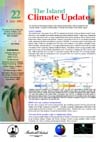An overview of the present climate in the tropical South Pacific Islands, with an outlook for the coming months, to assist in dissemination of climate information in the Pacific region.
Number 22 – 11 July 2002
June’s Climate: The South Pacific Convergence Zone (SPCZ) extended east from the Solomon Islands toward Tuvalu. However, it was virtually non-existent further east in the Southwest Pacific. A large area of enhanced convection with areas of above average rainfall affected the region from the Solomon Islands west to Papua-New Guinea. In the north, the Inter-Tropical Convergence Zone (ITCZ) was further south than usual, enhancing rainfall and cloudiness over parts of Kiribati. An extensive region of divergence and mainly sunny conditions extended from Fiji east to the Southern Cook Islands, including Tonga, Samoa and Niue, with less than 50% of average rainfall in many areas. Rainfall was also below average over much of New Caledonia, Vanuatu and the Northern Cook Islands. Below average rainfall continued in some areas on the northern Queensland coast of Australia, extending into the western Coral Sea. Willis Island has now recorded 11 consecutive months with less than 75% of average rainfall. Unusually high mean air temperatures were associated with very warm sea surface temperatures around Fiji.
ENSO and sea surface temperatures (SST): In June, above average SST in the tropical Pacific and continuing negative SOI has increased the chance of an El Niño occuring to at least 85%. Currently, sea surface temperatures in the parts of the central equatorial Pacific are about 1.0°C warmer than normal. Notably, there was a westerly wind burst at the end of the month in Fiji and Western Kiribati.
Forecast validation: How well are we doing with our predictions?
Three month outlook: Above average rainfall is likely in Western and Eastern Kiribati, with average to above average rainfall in the Solomon Islands, Vanuatu and Tuvalu. Average to below average rainfall is likely in New Caledonia, Fiji, Samoa, Tokelau and Marquesas Islands.
Feature Article: El Niño Update.
Sources of South Pacific rainfall data

A complete copy of The Island Climate Update is available as an Adobe Acrobat PDF file. This does not contain any extra information over that obtained by clicking on the individual items above.
To view the PDF file, you'll need Adobe Acrobat Reader, which you can download free from Adobe.
